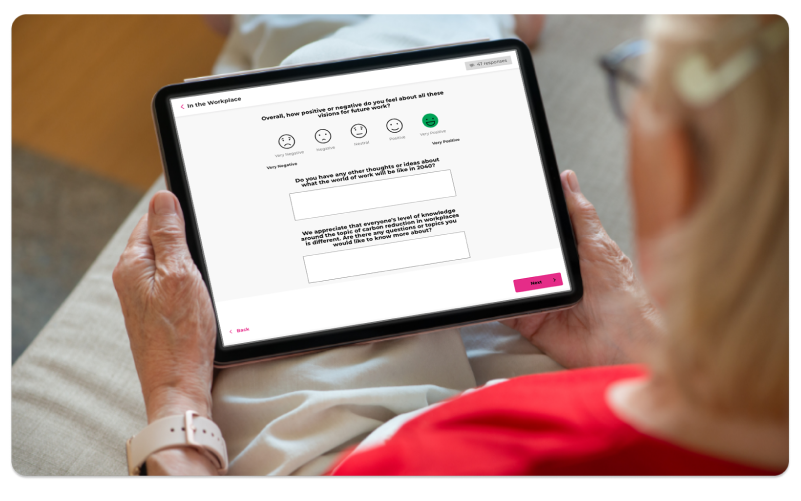Online vs offline: Creating a blended community engagement strategy

By Charlotte Cooper | 01/09/22 08:00
5 min read
Online or offline engagement? Does it really have to be a question of either/or? The short answer is no. The longer answer is that it’s beneficial and, in fact, recommended to use a blend of online and offline community engagement strategies to reach as broad a number of the community as possible.
Stay up to date with all our latest posts with our Community Engagement Newsletter!
With more footfall on the streets now thanks to the complete reopening of restaurants, shops and other public spaces within the UK, more and more public bodies and planners have been upping the physical presence of their community engagements alongside their digital efforts. But how are they achieving this balance?
At Commonplace, we’ve always advocated for a blended approach for consultations in order to capture the interest of as many people as possible. One thing the pandemic highlighted was the digital divide in certain areas of the community and the tools needed to actively seek out and engage with those who do not normally share their voice in typical community engagements (sometimes referred to as the silent majority).
Based on our experience of some 2000 projects, we have developed Commonplace to enable our customers to ask anything and ask anyone (within the bounds of the law). This is achieved through using a mix of both online and offline community engagement tools. In this blog, we will discuss reaching the mix that can work best for your next project.
Let’s get started.
Changing online habits
As we move into a new phase of the Covid-19 pandemic, online habits have started to change. While internet use remains almost constant in many people’s daily lives, there has been some change in online habits this year. According to the office of national statistics, online spending started to drop* and while internet use continues to grow as it has done year on year, but has slowed slightly as the world began to open back up in 2022.
So what do these trends mean for community engagement? In short, we saw a massive shift as the pandemic took hold in 2020. Previously popular in-person meetings and community gatherings had to be disbanded with online replacements quickly taking hold. It also highlighted how far an online consultation could reach with information now available 24/7 and to anyone with internet access. Now in 2022, online engagement is still growing (we’ve now hit 5.5 million unique website visitors!), but have also seen that many authorities are pairing their digital engagement hubs with physical events and marketing.
The reach of online community engagement
.png?width=800&name=Social%20media%20promotion%20-%20header%20(1).png)
Availability: Unlike people, the internet never sleeps. Where in-person meetings can only cater to those who are available then, an online platform will have all your information ready to view at any time. No need to see when the town hall is free next!
A single informational hub: With one online hub, all information can easily be added and updated so project developments are accessible. Not to mention, maintaining one online platform can be much more flexible and cost-effective than travelling around and setting up physical meetings.
Transparency: One barrier to community engagement can often be distrust between planners and the community. With a number of people believing that developments are done in secret to ‘avoid public backlash’, having all your plans freely available can help build trust. Plus, with Commonplace, Heatmaps allow anyone to feedback and the comments are publicly available. Seeing neighbours and friends commenting can encourage others to do the same and greatly boost engagement.
Building long-lasting relationships: Taking the time to build real lasting relationships with the community takes time and effort, especially if you’re doing it face to face. With an online engagement portal, you can easily keep in contact with the community through comments, updates, emails and more. It doesn’t have to end when your project does, and taking the time to continue talking with local people can lead to warmer feelings when your next project rolls around.
Offline community engagement strategies

Accessibility: Even nowadays, not everyone has constant or reliable access to the internet. Having a fully online strategy could alienate some people, especially those who are already used to more physical methods of engaging with local authorities. The massive online shift in 2020 did highlight the social isolation of some groups due to accessibility issues. For example, those over 65 in the UK have a lower proportion of internet connections, many finding themselves even more isolated as quarantine hit. **
The personal touch: No matter the subject, the ability to talk to someone face to face is a luxury many of us missed throughout 2020. This year, being able to actually visit places is almost an exciting concept. Plenty of us are tired of staring at Zoom day in, and day out with in-person meetings is a nice breath of fresh air.
Luckily an engagement strategy doesn’t have to be all or nothing. You can take all of the above points and use them to create a strong blended approach. Engaging the community is about having an open, two-way conversation. Being accessible to as many people as possible will not only get you more data in the long run, but show that you want to put in the extra effort to communicate.
Planning a blended engagement strategy
So, what does a blended engagement strategy look like? We’ve listed some points below to help you get started.
Choosing your setup: Whatever type of project you’re working on, an online hub will keep all your information together. This is a great place to start as you can work out exactly what you need for your project. For example, if you’re looking to work on a climate plan, you could focus on creating a hub to share events about climate initiatives. Or, if you’re transport planning, you could incorporate ongoing stakeholder feedback to keep on top of the consensus around your plan.
Create awareness: Creating awareness is a number one priority when it comes to any local project. After all, who’s going to give you feedback if no one knows what’s going on? Luckily, there are several ways to do this and you can use whichever works best for you.
If you have an existing contact list, it’s easy to talk to them directly with a targeted email campaign. You can send this the second your website goes live and give recipients the option to subscribe. This way, you can give project updates frequently and allow community members to contribute with further feedback.
Social media is an excellent tool to reach those in your local area and, depending on the platform, has the added bonus of being able to reach younger members of the community. With Commonplace, we can always set up targeted social media campaigns for you based on location, interests, certain demographics and more. All you have to do is ask.
Creating awareness doesn’t just stop with online methods either. With our offline engagement pack, you can generate all sorts of design assets or set up QR codes for billboards, bus stops, lamp posts and flyers. Perfect for creating a presence on the actual street.
Present information clearly: One thing that is absolutely crucial for a successful engagement campaign is that all your information is clear and easily accessible. This is where a blend of online and offline engagement tools comes in very handy. If you’re a fan of in-person meetings and proposals, these can absolutely still go ahead, but consider recording or live streaming them so those who can’t make it can still see what was discussed.
Information should always be up to date and presented regularly as well. With Commonplace’s news feature, it’s easy to post updates about projects, events and to show exactly where residents can find the information they’re looking for.
Start a conversation: Any engagement project is a two-way street, so making sure people can discuss anything easily and freely is a must. One way to do that is with a community Heatmap. With this, people can choose the exact location they want to leave a comment on while also being able to agree and comment on other people’s pins. With Commonplace, you can customise a whole series of questions, but choose carefully! The right survey questions are crucial for getting useful and actionable data. If you’re still planning in-person events or know of people that can’t engage, you can always have these conversations face to face or use paper/tablet surveys. It’s easy to add that data to the website so all your answers are in one convenient location.
Analyse: Once you’ve started to collect all your on and offline community data, it’s time to analyse. It’s crucial to track answers periodically as the conversation around your project will be ever-evolving. Plus, you can see exactly which demographics are getting involved and adjust your plan if certain areas of the community aren’t engaging. With us, you can see exactly which marketing channels are driving engagements so you can focus and improve your strategy. It’s an ongoing conversation after all, so it’s good to check if you’re reaching as many people as you can.
Ready to create your blended community engagement strategy? Just get in touch and we'll be more than happy to take you through the platform.
ONS data

